
Arches have been an iconic architectural element for centuries, adding a touch of elegance and grandeur to any structure. Not only do they serve as a structural support, but they also provide a visual appeal to the overall design. While most people are familiar with traditional arches in churches and historic buildings, there are numerous modern and unique arch designs that can be incorporated into residential architecture. In this article, we will explore seven different types of arches that can add a touch of uniqueness and charm to your home. From round to pointed, curved to angular, these arches will transform your space into a work of art. So let’s dive into the world of arches and discover the endless possibilities for your home.
7 Unique Types of Arches for Your Home
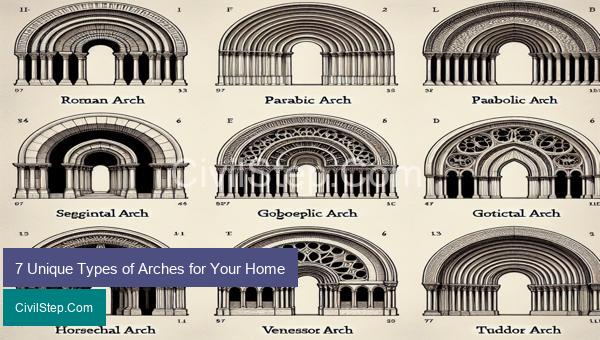
Arches are architectural elements that have been used for centuries to add beauty, functionality, and structural support to buildings. They are curved structures that span an opening, distributing the weight of the building above them. In addition to their structural purpose, arches also add a unique and elegant touch to any home. Here are 7 unique types of arches that can be incorporated into your home design.
1. Roman Arch
The Roman arch, also known as a semi-circular arch, is one of the oldest forms of arches. It has a half-circle shape and is typically composed of wedge-shaped blocks known as voussoirs. The Roman arch was widely used in ancient Roman architecture and is still commonly seen in homes today. This type of arch is perfect for adding a touch of classical elegance to your home.
2. Gothic Arch
The Gothic arch is characterized by its pointed or ogival shape. It was a popular architectural element during the Gothic era and is commonly seen in churches and cathedrals. The pointed shape of this arch allows for a taller and narrower opening, making it suitable for tall and narrow spaces. The Gothic arch adds a touch of grandeur and drama to any room in your home.
3. Horseshoe Arch
The horseshoe arch is a type of arch that has been used in Islamic architecture for centuries. Its name comes from its shape, which resembles the curve of a horseshoe. This type of arch is wider at the base and tapers towards the top. The horseshoe arch adds an exotic and unique touch to any home, making it a popular choice for those looking to add a touch of cultural influence to their design.
4. Elliptical Arch
As the name suggests, the elliptical arch has an elliptical shape. It is similar to the Roman arch, but the curved shape is less pronounced. The elliptical arch was often used in Renaissance architecture and is commonly seen in grand entranceways and doorways. This type of arch adds a touch of elegance and sophistication to any home design.
5. Basket Handle Arch
The basket handle arch, also known as a depressed arch, has a shape that resembles an upside-down basket handle. It is wider at the top and narrower at the base, providing a wider opening compared to other types of arches. This type of arch is commonly used in country-style homes and adds a rustic and charming touch to any design.
6. Trefoil Arch
The trefoil arch, also known as a three-lobed arch, is a decorative type of arch that was popular during the Gothic era. It is characterized by its three-lobed shape, resembling a three-leaf clover. This type of arch adds an intricate and ornate touch to any home, making it a popular choice for those looking to add a touch of Gothic or medieval influence to their design.
7. Parabolic Arch
The parabolic arch is a type of arch that has a parabolic shape, with the curve being defined by a mathematical equation. This type of arch is commonly used in modern architecture and is often seen in bridges, stadiums, and theatres. It provides a unique and modern touch to a home design, making it a popular choice for those looking to incorporate contemporary elements into their home.
Arches

Arches are a type of architectural feature that has been used for centuries in both the construction of buildings and bridges. They are structures that are designed to span an opening or support the weight of a structure above. The basic design of an arch consists of a curved shape supported by two vertical posts known as abutments on either end.
The strength of arches lies in their ability to distribute weight evenly along their structure, making them ideal for supporting heavy loads. This is due to the fact that the shape of an arch is naturally self-supporting. The curved shape allows the weight of the structure to be transferred along the arch to the abutments, which in turn transfers the weight to the ground.
One of the most famous examples of arches can be found in ancient Roman architecture, such as the Pont du Gard aqueduct in France and the Colosseum in Italy. These feats of engineering are still standing today, a testament to the durability and strength of arches.
There are different types of arches, depending on their shape and construction method. Some of the most common types include the round arch, pointed arch, and horseshoe arch. Round arches are semi-circular in shape, while pointed arches have a pointed apex at the top. Horseshoe arches are round at the bottom and have a pointed arch at the top.
In modern times, arches are still widely used in architecture, particularly in bridge construction. They can also be found in religious buildings, such as churches and mosques, and even in residential homes as decorative features.
As a civil engineer, it is important to consider various factors when designing arches, such as the type of materials used, the span or distance between the abutments, and the height of the arch. The material used may vary depending on the purpose of the arch, with some materials being better suited for carrying heavy loads, while others are more suitable for decorative purposes.
In conclusion, arches are a versatile and enduring architectural feature that has been used for centuries. Their unique design and strength allow them to span large openings and support heavy loads, making them an important element in civil engineering and construction. From ancient Roman ruins to modern-day structures, arches continue to be a significant aspect of engineering and architecture that will stand the test of time.
8 Attractive Types of Arches

1. Roman Arch: This is one of the earliest and most iconic types of arches, dating back to ancient Roman architecture. It is characterized by a semicircular shape and a keystone at the top, which allows for even distribution of weight and provides stability.
2. Gothic Arch: This type of arch is commonly seen in Gothic-style cathedrals and churches. It has a pointed shape, with a higher arch and thinner walls compared to a Roman arch. The pointed shape also allows for taller and more intricate designs.
3. Horseshoe Arch: As the name suggests, this type of arch has a distinctive horseshoe shape with a wider base and narrower top. It is commonly used in Spanish and Moorish architecture and adds a unique and visually appealing element to the design.
4. Islamic Arch: This arch is characterized by its multifoil shape, with several overlapping arches forming a symmetrical geometric pattern. It is commonly seen in mosques and Islamic buildings and adds a sense of grandeur and intricate detail to the design.
5. Trefoil Arch: This type of arch is similar to the Islamic arch, but with three equal lobes instead of multiple. It is commonly used in Gothic architecture and adds a decorative touch to the design.
6. Ogee Arch: This arch has a distinctive double-curve shape, resembling an inverted letter S. It is commonly seen in traditional Chinese and Japanese architecture and is also used in Gothic and Renaissance designs.
7. Basket Arch: This arch has a unique basket-like shape, with a wider base and a narrower top. It is commonly used in Spanish architecture and adds a decorative and elegant touch to the design.
8. Parabolic Arch: This type of arch has a curved shape that resembles a parabola curve. It is commonly used in modern architecture and provides a sleek and contemporary look to the design. It is also known for its strength and ability to span long distances without the need for additional support.
Closing Thoughts

As I reflect on my experiences as a civil engineer, I am filled with a sense of pride and fulfillment. Building and maintaining the physical infrastructure that enables society to function is a challenging yet rewarding task. Whether it’s designing roads and bridges, constructing tall buildings, or managing large-scale projects, civil engineering has a significant impact on people’s lives.
One of the most rewarding aspects of being a civil engineer is witnessing the results of my hard work. Seeing a structure I helped design come to life or driving on a road I helped build fills me with a sense of accomplishment. It is a tangible reminder that my contributions have a lasting impact on society.
Another aspect that I appreciate about civil engineering is the constant learning and problem-solving involved in the field. Every project is unique, and with each one comes new challenges and opportunities to expand my knowledge and skills. This continuous learning process keeps me engaged and motivated to find innovative solutions that benefit the community.
However, being a civil engineer also comes with immense responsibility. The structures and systems we design have a significant impact on the safety and well-being of people. This responsibility requires a high level of attention to detail, adherence to codes and regulations, and the ability to make sound decisions in critical situations. It is a constant reminder to always strive for excellence and prioritize the safety of the public.
In conclusion, my journey as a civil engineer has been a fulfilling one, and I am grateful for the opportunities and challenges it has presented. The work we do may not always be glamorous, but knowing that it serves a crucial purpose in society is what makes it all worth it. As I continue on this path, I am excited about the new advancements and innovations in the field that will further enhance our ability to build a better world for future generations.
Semi-Circular Arch
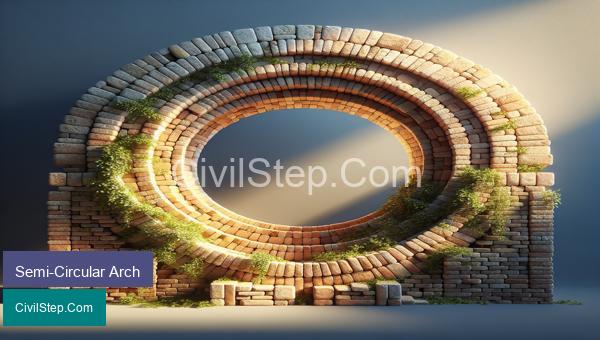
Semi-circular arches are one of the most commonly used structural elements in civil engineering. They are typically used in bridge construction, as well as in buildings and other structures. A semi-circular arch is a half-circle shaped support system that distributes the weight of a load placed on it evenly across its base.
The design of a semi-circular arch involves two basic components – the arch itself, which is the curved structure, and the abutments or supports on either end of the arch. The semicircular shape provides a natural curve that is ideal for resisting the pressure and weight of a load placed on top of it.
One of the main advantages of using a semi-circular arch is that it can span a large distance without the need for intermediate supports. This makes it a popular choice for bridge construction, as it allows for the creation of long, open spans without the need for additional columns or supports that would obstruct the waterway underneath.
There are two types of semi-circular arches commonly used in civil engineering – a single arch and a double arch. In a single arch design, the load is distributed evenly across the entire curvature of the arch. This type is commonly used in small bridges or as decorative features in buildings.
A double arch design, on the other hand, consists of two semi-circular arches placed side by side and connected at the top. This allows for a wider span and can support a higher load than a single arch. Double arches are commonly used in larger bridges and structures where a greater weight distribution is required.
In addition to their strength and versatility, semi-circular arches are also aesthetically pleasing, making them a popular choice for architectural designs. Their graceful curves can add visual interest and enhance the appearance of a structure.
However, there are also some limitations to using semi-circular arches. One of the main challenges is determining the right amount of curvature and the appropriate height of the arch, as these factors directly affect the load-carrying capacity. Additionally, the curved shape of the arch can make it more difficult to construct than straight structures.
In conclusion, semi-circular arches are a reliable and versatile structural element commonly used in civil engineering. With proper design and construction, they can withstand heavy loads and span long distances without the need for additional supports. Their aesthetic appeal and flexibility make them a popular choice for a variety of construction projects.
Horseshoe Shape Arch
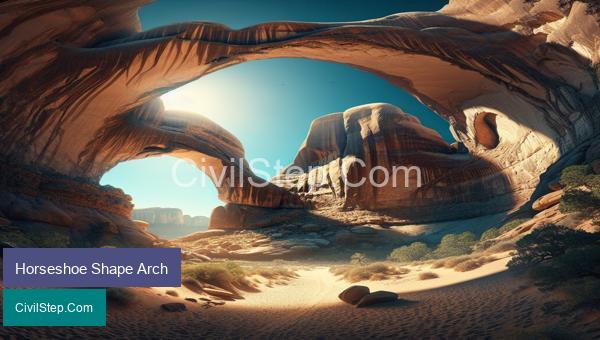
A horseshoe shape arch is a type of arch that is curved in a semi-circular shape resembling a horseshoe. It is commonly used in architecture and civil engineering to create sturdy and visually appealing structures such as bridges, tunnels, and buildings. The unique shape of the horseshoe arch makes it a popular choice among engineers for its stability, strength, and aesthetic appeal.
History
The horseshoe shape arch has a long history and has been used in architectural designs since ancient times. It was first used in the Middle East and North Africa and later spread to Europe during the Islamic conquests in the 7th and 8th centuries. The Alhambra, a fortress and palace in Granada, Spain, is a famous example of the use of horseshoe arches in Islamic architecture.
Design and Construction
Horseshoe arches are formed by joining two semi-circular arches at their base, creating a continuous rounded shape. They are commonly constructed using materials such as stone, brick, and concrete. The arches are usually reinforced with steel or iron bars to increase their strength and durability. The width of the arch is typically one-fifth of its height, ensuring structural stability and reducing the load on the foundations.
Advantages of Horseshoe Shape Arch
The horseshoe shape arch has several advantages over other arch shapes, making it a preferred choice for engineers in various construction projects.
1. Sturdiness and stability: The curvature of the horseshoe arch evenly distributes the load and weight exerted on the structure, making it more stable and resistant to collapse due to external forces such as wind, earthquakes, and heavy loads.
2. Aesthetic appeal: The elegant and graceful design of the horseshoe arch adds a touch of beauty to any structure. Its symmetrical shape makes it a popular choice in architectural designs, creating a sense of balance and harmony.
3. Ability to span large distances: Due to its unique shape, the horseshoe arch has the ability to span larger distances than other arch shapes. This makes it an ideal choice for constructing bridges and tunnels.
4. Cost-effective: The use of horseshoe arches can reduce the cost of construction as it requires fewer materials and has a simple and easy construction process.
Applications
Horseshoe shape arches can be found in various structures across the world, from historic buildings to modern-day structures. Some of the most famous examples include:
– The Great Mosque of Cordoba in Spain, which has a series of horseshoe arches in its interior design.
– The Gateway Arch in St. Louis, Missouri, which is a 630-foot tall arch spanning the Mississippi River.
– The Brooklyn Bridge in New York, which has two horseshoe arches supporting its towers.
– The Dome of the Rock in Jerusalem, characterized by its stunning golden dome supported by horseshoe arches.
In addition to these iconic structures, horseshoe arches are also used in modern-day constructions such as airports, stadiums, and commercial buildings.
In conclusion, the horseshoe shape arch is a timeless architectural element that not only adds an aesthetic appeal to structures but also provides stability, strength, and versatility. As a civil engineer, understanding the design and advantages of this arch shape is crucial for creating durable and visually appealing structures.
Segmental Arch
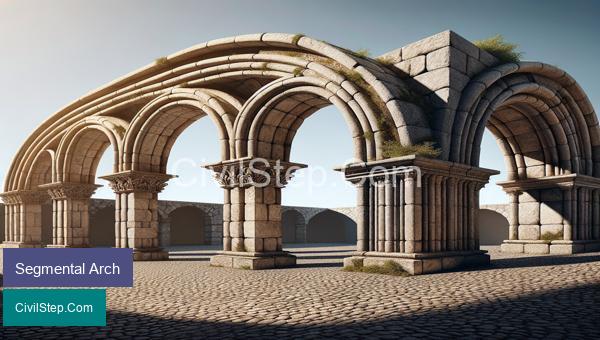
A segmental arch is a type of arch structure that consists of multiple segments or arches arranged in a semi-circle or a curved line. It is one of the most commonly used arch designs in civil engineering, known for its strength and durability. Segmental arches have been used in various structures throughout history, from ancient Roman aqueducts to modern day bridges and buildings.
The main feature of a segmental arch is its curved shape, which allows for the transfer of loads and weight along its curved path, making it more resilient to external forces. The arch is supported at the ends by the abutments or piers, which act as the foundation for the structure. The arch itself is composed of several smaller segments, which are typically made of brick, stone, or reinforced concrete. These segments are key to the structural integrity of the arch, as they distribute the weight and forces evenly, preventing any one part from being overloaded.
One of the advantages of a segmental arch is its ability to span a large distance without the need for intermediate supports. This makes it an ideal choice for bridges, as it can span over rivers, valleys, and other obstacles. The curved shape also allows for a wider range of construction options, as it can accommodate different angles and heights. It is also more economical as it requires less material for construction compared to other arch designs.
To construct a segmental arch, engineers use a technique called centering, which involves building a temporary support structure to hold the arch segments in place until the mortar sets and the arch becomes self-supporting. The segments are carefully laid and bonded together using mortar, and once the arch is complete, the centering is removed, leaving a strong and stable structure.
In addition to its strength and versatility, segmental arches are also known for their aesthetic appeal. The graceful curve of the arch is pleasing to the eye and can add a sense of grandeur to any structure. It is commonly used in architecture, such as in the design of doorways, windows, and decorative features.
In conclusion, segmental arches are a popular choice in civil engineering due to their strength, versatility, and aesthetic appeal. They have stood the test of time and continue to be used in various structures across the globe, showcasing their enduring and timeless design.
Florentine Arch

The Florentine Arch, also known as the Persian Arch or the Eastern Arch, is a type of architectural arch commonly found in Romanesque and Gothic structures. Its unique design and construction make it a significant feature in the history of architecture.
Origins and Characteristics:
The Florentine Arch originated in the city of Florence, Italy during the medieval period. It is believed that the design was influenced by the Persian architecture that the Crusaders encountered during their battles in the Middle East. The arch is characterized by its horseshoe shape, with two curves converging at the top to form a pointed arch. The sides of the arch are usually decorated with intricate carvings and ornamental details.
Structural Significance:
The Florentine Arch is known for its strength and stability, making it a popular choice for spanning large openings in buildings such as churches, cathedrals, and castles. The two curves of the arch intersect at a sharp angle, creating tension that evenly distributes the weight of the structure and transfers it to the supporting columns or walls. This structural technique allowed for the creation of taller and wider buildings, which were not possible with the previously used round arch design.
Architectural Style:
The Florentine Arch became a defining feature of the Romanesque and Gothic architectural styles during the 12th and 13th centuries. It was commonly used in conjunction with other architectural elements, such as the rib vaults and flying buttresses, to create grand and imposing structures. The arch was also often used in conjunction with other types of arches, such as the pointed arch, to create a more complex and visually appealing design.
Evolution and Legacy:
Over time, the Florentine Arch evolved and was adapted into various architectural styles. It can be seen in churches and other buildings throughout Europe and the Middle East, including the famous Notre Dame Cathedral in Paris. In modern architecture, the arch is still used as a decorative element, but its structural significance has been replaced by more advanced engineering techniques.
In conclusion, the Florentine Arch is an iconic architectural feature that has stood the test of time. Its unique design and structural capabilities have made it an integral part of many historic buildings and continue to inspire architects and engineers to this day. Its legacy continues to live on as a testament to human ingenuity and the evolution of architectural styles.
Concrete Arch
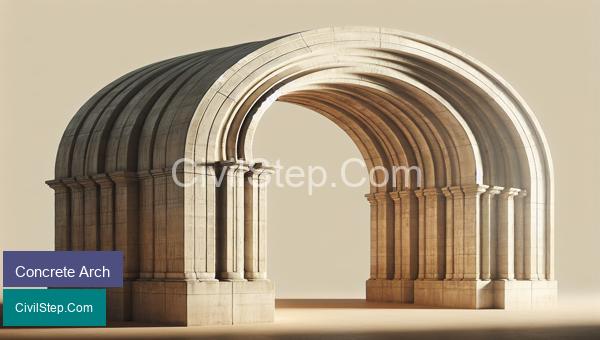
A concrete arch is a structural element that is commonly used in civil engineering projects. It is a curved structure that is designed to carry loads through compression, making it a versatile choice for different applications. The use of concrete in an arch construction offers many advantages, including its durability, strength, and cost-effectiveness.
The concept of an arch has been around for thousands of years, dating back to ancient Roman architecture. However, the use of reinforced concrete in arch construction is a relatively modern development. The use of concrete in arch construction came into play in 1880 when the St. Louis Bridge, the first long-span arch bridge, was completed.
There are various types of concrete arches, including fixed arches, two-hinged arches, and three-hinged arches. Each type has its unique structural characteristics, making them suitable for different applications.
One of the primary advantages of using concrete in arch construction is its strength. Concrete is highly resistant to compression, making it an ideal material for carrying heavy loads. The arch structure transfers the load through the support points, known as abutments, and distributes it evenly along the curve of the arch. This design allows for the reduction of the amount of material required, making it a cost-effective choice for construction.
Additionally, concrete arches are known for their durability. Concrete is a long-lasting material, and with proper design and maintenance, a concrete arch structure can have a lifespan of over a hundred years. This makes it a sustainable choice for civil engineering projects.
The construction process for a concrete arch involves creating a formwork that follows the curvature of the arch. Concrete is then poured into the formwork and allowed to harden, forming the arch shape. Reinforcement bars are often used to strengthen the concrete and provide additional support.
Concrete arches have numerous applications in civil engineering, typically in the construction of bridges, tunnels, and dams. They are also used in the construction of underground pipelines and canals, where they serve as a support structure.
However, like any structural element, concrete arches have their limitations. They are not suitable for areas with significant seismic activity, as they can be prone to cracking or failure in extreme conditions. Proper design considerations must be made to ensure the safety and stability of a concrete arch structure.
In conclusion, concrete arches are a fundamental element in civil engineering, offering strength, durability, and cost-effectiveness. Their unique structural characteristics make them suitable for various applications, making them a preferred choice in many construction projects.
Brick Arch

A brick arch is a type of architectural element that is commonly used in the construction industry. It is a popular choice for both aesthetic and structural purposes, due to its strength, durability, and versatility.
A brick arch consists of a series of brick or stone layers that are curved in shape, creating a semi-circular or elliptical opening. These layers are commonly referred to as voussoirs, and they are fitted together in a specific pattern to create a stable and self-supporting structure.
The construction process of a brick arch typically involves the use of a temporary wooden or metal frame, called a centering, to support the bricks as they are being laid. The centering is key to ensuring the correct curvature and stability of the arch.
There are several different types of brick arches, each with its own unique design and construction method. Some of the most common types include the circular arch, the semi-circular arch, the segmental arch, and the pointed arch. Each type has its own advantages and is suitable for different applications.
One of the main advantages of using a brick arch is its strength and load-bearing capabilities. The curvature of the arch allows for the weight of the structure above it to be distributed and transferred evenly to the supporting walls or columns on either side. This makes brick arches a popular choice for bridges, tunnels, and other structures that need to span a large distance.
In addition to its structural benefits, a brick arch also adds an aesthetic appeal to a building. The use of bricks in the construction of an arch allows for intricate designs and patterns to be created, adding character and charm to the overall design.
However, building a brick arch requires a high level of skill and precision. Professional masons are typically employed to ensure that the bricks are laid accurately, with each layer properly aligned to create a stable and visually appealing arch.
In modern construction, brick arches are often combined with other building materials such as steel or reinforced concrete to enhance its strength and stability. This hybrid construction method is known as the composite arch and is commonly used in larger or more complex structures.
In conclusion, a brick arch is a classic and timeless architectural element that offers both structural and aesthetic benefits. Its construction requires a high level of skill and attention to detail, making it a symbol of quality and craftsmanship in the building industry. Whether used in a traditional or contemporary setting, brick arches continue to be a popular choice for architects, builders, and homeowners alike.
Stone Arch
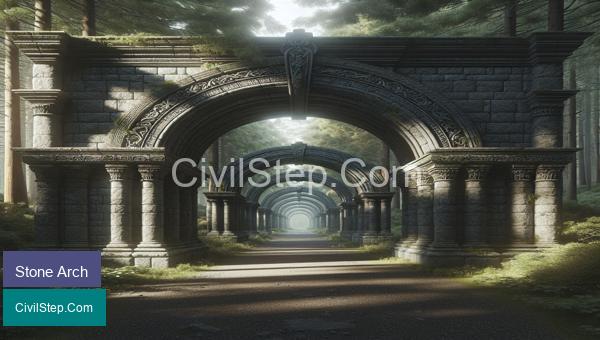
A stone arch is a type of architectural structure that is commonly used in civil engineering projects. It is known for its strength, durability, and aesthetic appeal. Stone arches have been used in construction for thousands of years and have stood the test of time, making them a popular choice for many different types of structures around the world.
Stone arches are typically made of natural stone, such as granite, limestone, or sandstone, which are all strong and durable materials. These stones are carefully cut to size and placed in an overlapping pattern to create a curved shape that can span over large openings. The stones are then secured in place with mortar or a concrete mixture to create a stable structure.
The most distinctive feature of a stone arch is its curved shape, which is what allows it to support weight and distribute it evenly across the entire structure. This characteristic also gives the arch its strength, as the compressive forces created by the weight of the structure are transferred to the supportive walls on either side of the arch.
Stone arches are commonly used in bridges, tunnels, and aqueducts, where they provide a strong and stable support system. In bridges, the arches are usually built beneath the roadway, allowing for a wider span and reducing the need for supporting columns. This design not only gives the bridge a more aesthetically pleasing appearance but also allows for unobstructed water flow underneath.
One of the most famous examples of a stone arch bridge is the Pont du Gard in southern France, which was built by the Romans around the first century AD. This three-level aqueduct bridge is approximately 50 meters tall and has a span of over 275 meters. It is a testament to the strength and durability of stone arch construction, as it still stands today despite being over 2,000 years old.
In addition to their practical uses, stone arches are also often used for decorative purposes in architecture. They can be found in the facades of buildings, as grand entrances, or as ornamental features on walls. The intricate patterns created by the overlapping stones and the curvature of the arch make for a visually striking element in any structure.
However, due to the labor-intensive process of cutting and assembling the stones, stone arches can be more expensive to construct compared to other types of arches, such as steel or concrete. They also require skilled labor and specialized equipment to ensure their proper construction.
Furthermore, stone arches can be susceptible to damage from natural elements such as earthquakes, weathering, and erosion. Therefore, regular maintenance and repairs are necessary to ensure their longevity.
In conclusion, stone arches have been an essential part of civil engineering for centuries, providing strength and stability to various structures. Their unique design and enduring strength have made them a popular choice for both functional and decorative purposes. As a civil engineer, understanding the principles of stone arch construction is crucial for designing and constructing safe and durable structures that will stand the test of time.
Lancet Arch

The Lancet Arch, also known as the pointed arch, is a distinctive architectural feature that originated in the Romanesque period and became prevalent during the Gothic period. It is characterized by a narrow, pointed shape with a gentle curvature at the top, resembling an upside-down arch.
The term “lancet” is derived from the shape of a lance or spear, which the arch resembles. This style was first used in religious architecture, particularly in cathedrals, where it was used to create tall and elegant windows. The pointed shape allowed builders to create larger and more elaborate windows with minimal structural support, making it an ideal choice for grand and dramatic designs.
One of the most famous examples of Lancet Arch is the Notre-Dame Cathedral in Paris, which features numerous pointed arches in its façade and interior. Other notable examples can be found in the Chartres Cathedral in France, the Cologne Cathedral in Germany, and the York Minster in England.
The Lancet Arch not only has aesthetic value but also serves functional purposes. It distributes the weight of the building evenly across the supporting columns or walls, reducing the stress on any one point. It also allows for taller and wider openings, which provide increased natural light, improving the overall interior lighting of a space.
The invention of the Lancet Arch allowed for new engineering techniques and architectural designs. It also played a significant role in the advancement of Gothic architecture, as it became the primary form of arch used in that style. The pointed shape of the arch also influenced other elements of Gothic architecture, such as ribbed vaults and flying buttresses.
In modern times, the Lancet Arch is still widely used in architectural designs and can be found in various buildings, both religious and secular. It continues to be a symbol of strength, elegance, and grandeur in the structures it adorns.
In conclusion, the Lancet Arch is a significant architectural feature that has stood the test of time. Its unique design and functional benefits have made it a staple in architectural styles throughout history. As a civil engineer, understanding the evolution and use of the Lancet Arch is crucial in preserving and appreciating the rich history and beauty of architectural design.
Conclusion
In conclusion, incorporating arches into your home design not only adds an architectural element but also creates a unique and eye-catching feature. From the classic Roman arch to the whimsical Tudor arch, there are endless possibilities to choose from. Consider the style and overall aesthetic of your home when deciding which arch type best fits your space. Whether you opt for a grand archway or a subtle arch detail, adding any of these 7 unique arches is sure to enhance the beauty and charm of your home. So why settle for a plain and ordinary entryway or doorway when you can elevate your home’s design with one of these stunning arch types? Let your imagination run wild and make a statement with arches in your home.
